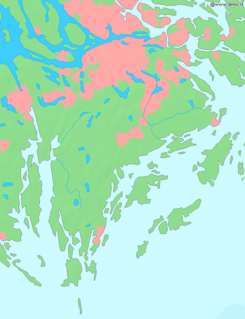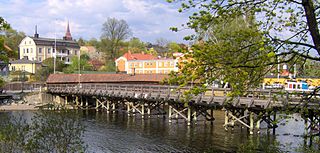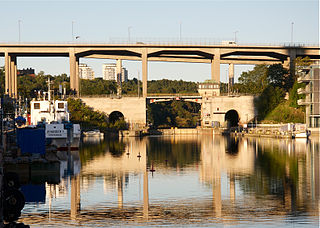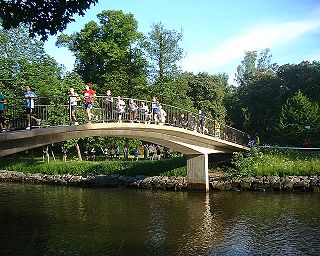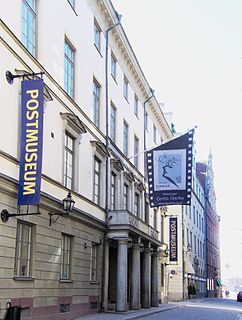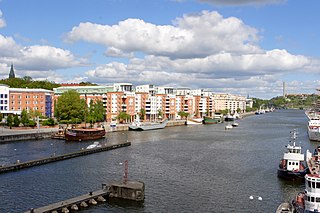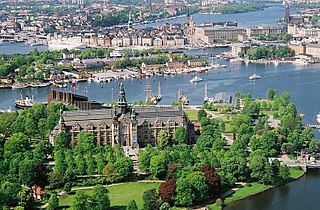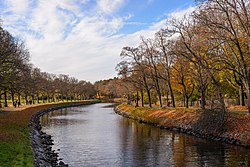

Djurgårdsbrunnskanalen (Swedish: "The Djurgården Well Canal") is a canal in central Stockholm, Sweden, separating the island Djurgården from the northern mainland (or more correctly Southern and Northern Djurgården).
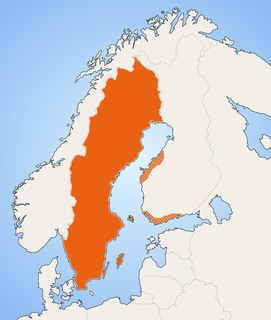
Swedish is a North Germanic language spoken natively by 10 million people, predominantly in Sweden, and in parts of Finland, where it has equal legal standing with Finnish. It is largely mutually intelligible with Norwegian and to some extent with Danish, although the degree of mutual intelligibility is largely dependent on the dialect and accent of the speaker. Both Norwegian and Danish are generally easier for Swedish speakers to read than to listen to because of difference in accent and tone when speaking. Swedish is a descendant of Old Norse, the common language of the Germanic peoples living in Scandinavia during the Viking Era. It has the most speakers of the North Germanic languages.

Canals, or navigations, are human-made channels, or artificial waterways, for water conveyance, or to service water transport vehicles.
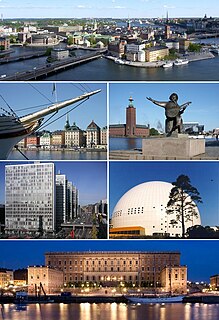
Stockholm is the capital of Sweden and the most populous urban area in the Nordic countries; 962,154 people live in the municipality, approximately 1.5 million in the urban area, and 2.3 million in the metropolitan area. The city stretches across fourteen islands where Lake Mälaren flows into the Baltic Sea. Just outside the city and along the coast is the island chain of the Stockholm archipelago. The area has been settled since the Stone Age, in the 6th millennium BC, and was founded as a city in 1252 by Swedish statesman Birger Jarl. It is also the capital of Stockholm County.
Contents
The canal stretches one kilometre (0.6 mi) from Lilla Värtan to Djurgårdsbrunnsviken and allows ships 9.5 metres (31 ft) wide and 2.1 metres (6 ft 11 in) deep to pass. [1] Two bridges pass over the canal: Djurgårdsbrunnsbron and Lilla Sjötullsbron.
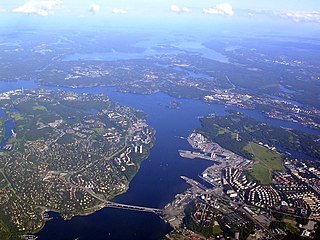
Lilla Värtan or simply Värtan is a strait in Stockholm, Sweden. Separating mainland Stockholm from the island and municipality Lidingö, it stretches from Blockhusudden in the south to Stora Värtan in the north, and is joined by the Stocksundet mid-way. Two bridges, collectively called Lidingöbron stretch over the strait.

Djurgårdsbrunnsviken is a bay in central Stockholm, Sweden, together with the canal Djurgårdsbrunnskanalen forming the northern shore line of the island Djurgården. The bridge Djurgårdsbron stretches over the bay.

Djurgårdsbrunnsbron is a bridge in central Stockholm, Sweden, connecting northern and southern Djurgården. It is the city's only remaining swing bridge, the default bridge type in Stockholm during the 19th century. It has been closed since 1966.
The decision to build the canal was made by King Charles XIV in 1825. The canal was completed in 1834. [2] It was built to make it easier for smaller ships with supplies to reach the center of Stockholm, but also for aesthetic reasons because Djurgården is a royal park.
